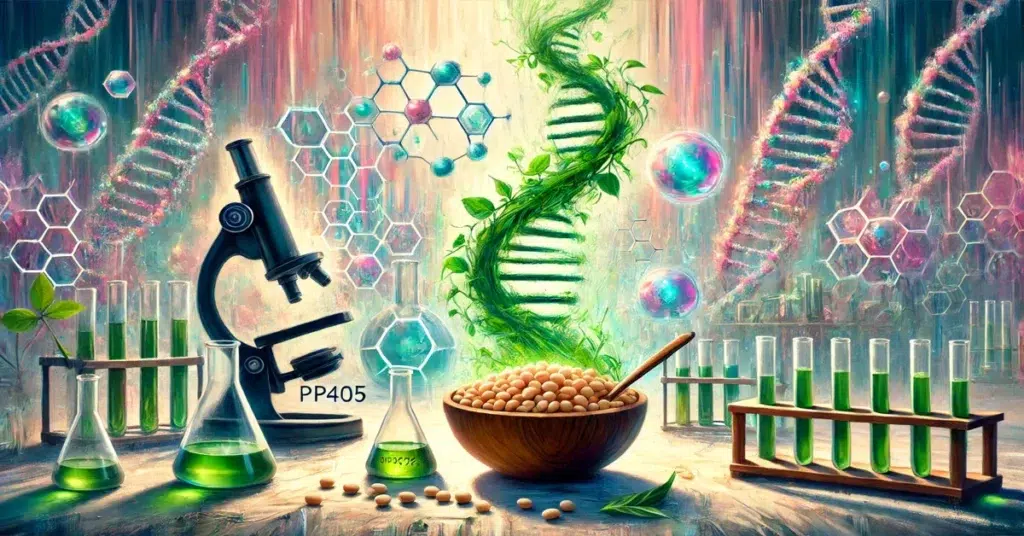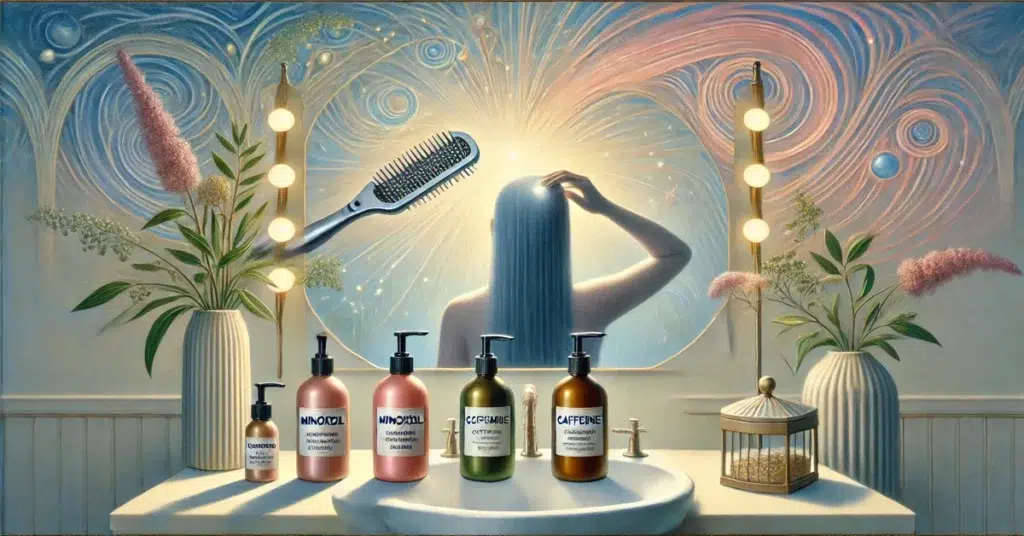🧬 Introduction: A New Era in Hair Regeneration?
What if your next hair transformation doesn’t come from a salon, a bottle, or even your genetics… but from a lab and a spoonful of fermented soybeans?
Sounds wild — but that’s exactly where science is heading.
Two seemingly unrelated discoveries are turning heads (and possibly regrowing them):
🧪 PP405, the molecule nicknamed “Botox for Hair Follicles,”
and
🌿 Spermidine, a naturally occurring compound praised for its anti-aging and hair-regrowth potential.

Individually, both show remarkable promise. But together?
They may just become the ultimate combo of future follicular therapy — merging cutting-edge biotech with time-tested nutritional support.
While PP405 is still in clinical trial stages, spermidine is already making waves in the nutrition and supplement world.
In this article, we’ll explore how these two forces might complement each other, what science says so far, and what you can do right now to support your hair — while the future of hair restoration slowly unfolds.
🌱 Meet Spermidine: The Natural Growth Booster Already in Your Body
Spermidine is a polyamine that naturally occurs in the human body and is found in foods like soybeans, aged cheese, wheat germ, and mushrooms. Often referred to as the “Swiss Army knife of longevity,” it plays a powerful role in cellular health, autophagy, and regeneration.
What makes it especially relevant to hair health is its ability to extend the anagen (growth) phase of the hair cycle.

As early as 2011, a study published in PLOS One demonstrated that spermidine:
- significantly prolonged the anagen phase,
- enhanced the expression of keratins involved in cell proliferation,
- and stimulated human hair follicle growth in culture.
Source: PubMed – 2011 study
Even more importantly, a 2017 clinical trial confirmed that oral spermidine supplementation noticeably increased hair growth duration in humans compared to placebo.
Source: PubMed – 2017 trial
Foods Rich in Spermidine
Although spermidine levels decline with age, you can naturally support them through diet. The best food sources include:
- fermented soybeans (natto),
- aged cheeses (especially Parmesan),
- wheat germ,
- mushrooms (shiitake, maitake),
- broccoli and green peas.
For a more detailed guide, check out our article:
👉 Best Food for Strong Hair
🔗 The Synergy: Why Combining PP405 and Spermidine Might Be a Game-Changer
At first glance, PP405 and spermidine seem like an odd couple — one is a lab-engineered molecule undergoing clinical trials, and the other is a naturally occurring compound found in aged cheese and soybeans.
But look closer, and you’ll find a compelling reason to consider them as complementary forces in the future of hair regeneration.
PP405 – The Follicle Activator
PP405 is designed to kickstart dormant follicle stem cells by reactivating mitochondrial function and cellular energy. In simple terms: it wakes up the hair follicles that have gone quiet, especially in areas affected by thinning or pattern baldness.
It’s not about covering up hair loss — it’s about stimulating the source.

Spermidine – The Growth Extender
Spermidine, on the other hand, doesn’t initiate growth — it prolongs it.
By extending the anagen phase and supporting cellular health, it helps ensure that once a follicle starts producing a hair strand, it keeps going strong for longer.
It works quietly but powerfully in the background — supporting longevity, reducing oxidative stress, and enhancing tissue resilience.
Why They Might Work Better Together
If PP405 is the spark that reignites growth, spermidine might be the fuel that keeps the flame burning.
Together, they could form a two-step system:
- PP405 activates follicle stem cells and kickstarts growth.
- Spermidine supports the process by keeping the follicle in its growth phase longer.
Although no official studies yet combine both directly, the science behind each suggests that their mechanisms don’t just coexist — they complement each other beautifully.
⏳ What You Can Do Now (While You Wait for PP405)
While PP405 is still undergoing clinical trials and spermidine research continues to expand, you don’t have to sit back and wait for science to catch up. There are practical, science-backed steps you can take today to support your scalp and hair health — and prepare the ground for future treatments.

Optimize Your Nutrition
Boosting your intake of spermidine-rich foods can help support the natural hair growth cycle from the inside out. Incorporating fermented soybeans, aged cheeses, wheat germ, and broccoli into your meals isn’t just trendy — it’s proactive hair care.
For those looking for more concentrated support, supplements containing spermidine are increasingly popular among people aiming to combine longevity and hair health. Many also contain zinc, biotin, B-vitamins, and plant-based antioxidants that work synergistically to combat oxidative stress and support scalp function.
Reduce Stress and Protect Hair Follicles
Stress is one of the most overlooked hair loss triggers — and it can disrupt hormonal balance, shorten the anagen phase, and increase inflammation in the scalp.
That’s why anti-stress supplements can be an essential part of your strategy. Formulas containing magnesium, Rhodiola Rosea, saffron extract, and B-complex vitamins have shown promise in reducing cortisol levels and creating a healthier internal environment for hair growth.
You can explore more about this connection in our article:
👉 How Stress Influences Hair Growth and Supplement Results
🧴 Reinforce Your Routine with Targeted Hair Products
Hair loss isn’t just about what happens on the inside — topical care plays a major role too.
Look for shampoos and conditioners that contain minoxidil as well as natural DHT blockers such as rosemary extract, caffeine, niacinamide, or ginseng. These ingredients may help maintain healthy follicles, reduce inflammation, and improve circulation to the scalp.

To enhance results, many users incorporate non-invasive laser therapy at home — a safe, FDA-cleared method to stimulate follicles and amplify the benefits of both topical and internal treatments.
Be Consistent — and Stay Informed
No matter what combination you choose, consistency is key. Hair growth happens slowly and subtly, and the most effective routines are the ones you stick to.
In the meantime, staying informed about promising therapies like PP405 and nutritional breakthroughs like spermidine keeps you ahead of the curve — and in control of your own hair journey.
Stay with us — the best is yet to come.
By following our advice, you’re doing the most you can for your hair.
Be the first to know when we publish new guides, tests, and proven strategies for stronger, healthier hair.
👉 Visit the About Me page to learn more about my journey, mission, and why helping people with hair health is so personal to me.
Want healthier, stronger hair? Discover 8 science-backed habits that protect your scalp and boost natural growth. Get your free PDF guide today!
Disclaimer: This article is for informational purposes only and is not a substitute for professional medical advice. Sensitive claims are supported with scientific references, and full product details can always be found on the official websites of the respective manufacturers or distributors.
Some links in this article are affiliate links. If you choose to make a purchase through them, I may earn a small commission at no extra cost to you — helping me keep HairGrowGenius running. Thank you for your support!

FAQ: PP405 and Spermidine – What People Are Asking
❓ Is PP405 available for purchase yet?
No. PP405 is still in the clinical trial phase and is not yet approved for public use. Any products claiming to contain PP405 are likely unregulated and potentially unsafe.
❓ Can spermidine actually help with hair growth?
Yes, studies have shown that spermidine can prolong the anagen (growth) phase of the hair cycle and support hair follicle health. While results vary, its cellular effects are backed by scientific evidence.
❓ Can I combine spermidine supplements with other hair growth treatments?
In most cases, yes. Spermidine is often used alongside biotin, zinc, and even treatments like minoxidil. However, it’s always smart to consult with a healthcare professional if you’re on other medications.
❓ Is it safe to take spermidine long-term?
Current research suggests that spermidine is safe for long-term use, especially when consumed through food. Supplementation should follow dosage guidelines and product quality should be verified.
❓ How soon could PP405 hit the market?
If Phase 3 trials are successful and regulatory approval is granted, PP405 might become available between 2027 and 2030 — but that depends on multiple factors, including trial outcomes and manufacturing readiness.
🧾 Last updated: July 2025 based on latest research.


Leave a Reply